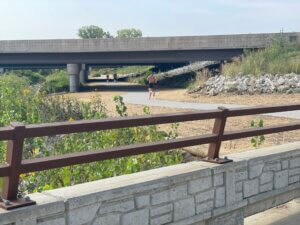

Multi-Use Trail - Easter Lake, Des Moines, IA
Trail Design
Our Path to Trail Design Success
Our trail design practice began in the early 1990s and has seen substantial growth. In the intervening years, we’ve been proud to contribute to the planning and design of more than 400 miles of paved trails. As a leading force in the Midwest’s multi-use trail development, we approach each project with great enthusiasm.
Our work is driven by a deep understanding of the latest industry standards and emerging best practices, as well as compliance with the policies set forth by the U.S. Department of Transportation (DOT) and state DOT regarding bicycle and pedestrian accommodations. This knowledge guides us in creating world-class trails.
Forging Community Connections Through Trail Design
Multi-use trails offer safe and efficient pathways for non-motorized transportation. They have a proven track record of boosting property values, fostering economic growth, and encouraging active lifestyles. These trails play a crucial role in connecting neighborhoods, schools, businesses, parks, and community facilities. Whether in small towns or bustling cities, these trails can be instrumental in establishing networks for both active transportation and recreational activities, ultimately enhancing the local and regional quality of life.
Building Project Support & Community Pride
Whether you’re embarking on the creation of a brand-new trail or revitalizing an abandoned railroad corridor, you’ll require a seasoned team to turn your vision into reality. We are well-equipped to tackle a range of challenges, including road crossings, intersections, pedestrian tunnels, bridges, right-of-way acquisition, and environmental considerations.
By carefully considering your project goals and incorporating innovative and sustainable practices, we tailor our solutions to meet the specific needs of your trail users. To gain support for your project, we facilitate the formation of advocacy committees consisting of individuals, businesses, organizations, and agencies. Through these committees, we establish a sense of local ownership for the trails and trail segments, fostering community pride.
Throughout all project phases, we maintain close coordination with funding authorities, regulatory agencies, public officials, and other stakeholders to ensure the success of your project.
Funding & Grant Writing Assistance
Securing funding for trail projects is highly competitive and often involves a protracted and demanding process. Projects like the High Trestle Trail typically rely on a combination of funding sources, including private donations, state and federal grants, as well as allocations from government budgets. With our extensive experience and comprehensive understanding of various funding avenues, we offer assistance in navigating this complex funding landscape.
Our Trail Design Services
Trail Design & Planning
We strive to strike a balance between adhering to design standards and meeting funding requirements while also minimizing the environmental impact of our trail projects. Our approach focuses on integrating the project seamlessly with its natural surroundings, where we find inspiration in the intersection of mathematics and topography, creating a harmonious blend of functionality and aesthetics.
Bridges & Tunnels
Our portfolio includes the design and construction of more than 100 pedestrian structures, which encompass tunnels and bridges spanning from 13 feet to 2,560 feet in length. Our expertise extends to a wide range of projects, such as the restoration of historic structures, the adaptation of bridges originally intended for different modes of transportation, tunnel installations beneath active traffic corridors, and the creation of entirely new bridges. In essence, we’ve successfully tackled every barrier that has come our way. Learn more about our bridge and tunnel services here.
Trailhead & Oasis Design
Thoughtfully placed trail amenities play a crucial role in improving the overall user experience. In addition to the practicality of features like restrooms, water sources, and repair stations, it’s equally essential to consider the aesthetics and viewpoints associated with these amenities in the design process.
Intersection Treatments
Ensuring safety is our top priority when trails intersect with roadways. Whether it involves a paved crossing over a gravel road or the installation of a pedestrian traffic signal, we offer our expertise in designing intersections and implementing traffic control measures that are appropriate and effective.
Maintenance & Rehabilitation
As trails age, deterioration is inevitable, and we recognize the challenge of allocating limited resources to address maintenance and repair demands. We can provide valuable assistance by developing trail maintenance plans and designing rehabilitation methods aimed at extending the lifespan of your trail.

